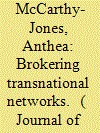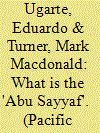| Srl | Item |
| 1 |
ID:
161465


|
|
|
|
|
| Summary/Abstract |
The current explosion of cocaine, illicit methamphetamine and fentanyl in the Asia Pacific is the result of increased collaboration between Chinese and Latin American organized crime groups operating across the Pacific littoral. These networks are connected through brokers who operate as channels between these discrete criminal. Recently, elements of these networks in the Pacific have begun to appear in the Indian Ocean region, demonstrating the cumulative reach of these criminal organizations. Australian law enforcement and intelligence officials will need to focus intelligence gathering activities on identifying key brokers in order to disrupt these criminal networks. Specific attention should be paid to emergent networks in the Indian Ocean which could prove to be the missing piece of the puzzle to understanding the scope and depth of these linked criminal organizations that operate across all four corners of the globe.
|
|
|
|
|
|
|
|
|
|
|
|
|
|
|
|
| 2 |
ID:
178940


|
|
|
|
|
| Summary/Abstract |
This article contributes to the growing literature on dark networks through an analysis on the Australian neojihadist network (ANN). Through analysis of Australian terrorist cells, we present a visualisation of the cells’ structures to determine how individuals are connected within each cell and to the wider ANN. A detailed analysis of six separate cells was undertaken to determine the operations, structures, and interactions of individuals within each cell. A visual network is presented to demonstrate how six cells that span a 14-year period form an interconnected network of individuals linked by family and close friendships. The insights gained through the analysis of this dark network sheds light on the origins, evolution, and structure of the ANN and highlight the way in which Australia’s experience with home-grown terrorism has evolved into an interlinked overarching illegal network that transcends both geographical locations and individual operations.
|
|
|
|
|
|
|
|
|
|
|
|
|
|
|
|
| 3 |
ID:
155740


|
|
|
|
|
| Summary/Abstract |
In recent decades, instructors have increasingly adopted the use of “serious” games in their classrooms. Typically, these games take the form of role-playing simulations or wargames. However, online computer-run games have opened up new possibilities: to explore complex conceptual relationships, to utilize and display asymmetric information, to be playable anywhere and by anyone, and more. This article describes the game, Dark Networks, and shows why this type of game is valuable as well as how it has been used for pedagogical gains.
|
|
|
|
|
|
|
|
|
|
|
|
|
|
|
|
| 4 |
ID:
106784


|
|
|
|
|
| Publication |
2011.
|
| Summary/Abstract |
Official sources and the media often represent the 'Abu Sayyaf' as a militant Islamist group or organization responsible for most atrocities in the southwestern Philippines. Frequently implicit within such representations is the assumption that the reported terrorist/bandit entity possesses the basic features of a conventional organization. Yet this assumption is irreconcilable with the many available descriptions of the armed groups labelled 'Abu Sayyaf' since the early 1990s. To resolve this incongruity, the article examines reigning perceptions of the 'Abu Sayyaf' in light of organization theory and network analysis. It begins with a summary of conventional definitions of organizations, before identifying alternative conceptual aids useful for understanding the phenomenon known as the 'Abu Sayyaf'. It then teases out the presuppositions that underpin popular views of the phenomenon through a sample of early military and rebel depictions. It compares those presuppositions with the structural features of the armed coalitions involved in two mass kidnappings attributed to the 'Abu Sayyaf'. The remainder of the article analyzes the 'Abu Sayyaf' in terms of 'dark' or illegal networks and supporting concepts from organization theory. To dispel the confusion surrounding the phenomenon, the article reviews the genealogy of the 'Abu Sayyaf' label in order to reveal the circumstances that gave birth to the perception of it as being a coherent group or organization. The article concludes with a brief ideal-typical interpretation of the covert networks in which the armed groups branded 'Abu Sayyaf' have been and continue to be enmeshed.
|
|
|
|
|
|
|
|
|
|
|
|
|
|
|
|